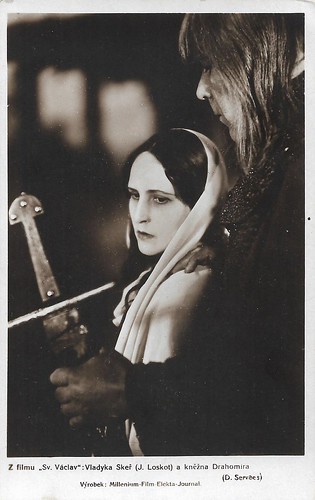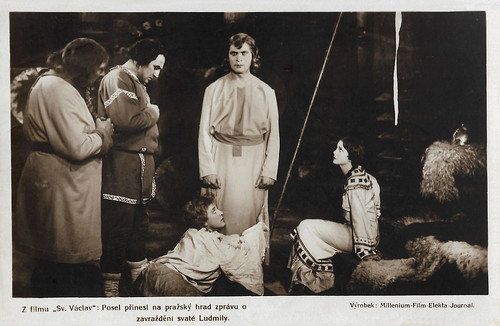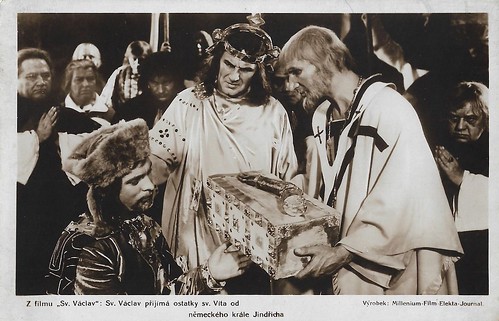
Czechoslovakian postcard by Nákladem K & P, Praha, no. c. 600, 1930. Photo: Millenium-Film-Elekta-Journal. Dagny Servaes as Wenceslaus' mother Dragomira in Svatý Václav/St. Wenceslas (Jan S. Kolár, 1930). Caption: The thane Skeř (Josef Loskot) with Princess Drahomira (Dagny Servaes).
An all-star cast
Svatý Václav/St. Wenceslas is a 1930 Czechoslovak historical film about Saint Wenceslas by Jan S. Kolár. It was the most expensive Czech film to date, with the largest set constructed in Europe to accommodate an all-star cast of over a hundred including Dagny Servaes as Wenceslaus's plotting mother Dragomira, and Vera Baranovskaya, the heroin of Vsevolod Pudovkin's classic Mat/Mother (1929), as grandmother Ludmila, killed by her own daughter. There were 5,000 extras for the lavish battle scenes.
The film initially received a loan of 1 million crowns from the government of Czechoslovakia — half of the film's original budget. However, the budget has been increased to 4 million crowns due to filming in winter. When the film was on a verge of being terminated the government lent the production another 1 million crowns. Prime minister František Udržal also provided military equipment as well as people from the state services to finish the film.
The shooting started in September 1929. Exteriors were shot in Prokopské údolí, Šumava primeval forest, Křivoklát, Brdy and Unhošť. Sets of Wenceslaus' and Boleslaus' castles were built at the Strahov Stadium based on designs by Ludvík Hradský, who studied historical sources to be historically accurate. Large reflectors needed to be built for shooting the night scenes. The generators and planes were provided by the Ministry of Defence. Some scenes were filmed using five cameras.
In December the production moved to Vinohrady's A-B Ateliers for interior scenes. The last big battle scene with Radslav was shot in March 1930. The whole film was shot over 82 filming days. Orchestral music was composed by Oskar Nedbal and Jaroslav Křička. It was originally thought that the music would be synchronised with the film, but the lack of funds proved this impossible. A 40-piece orchestra accompanied Svatý Václav/St. Wenceslas at its premiere. Some of the later screenings were with non-original music.
Wenceslaus was played by Czech actor, playwright, director and screenwriter Zdeněk Štěpánek, considered one of the most prominent and well-known Czech stage and screen actors of the 20th century. In cinema, he portrayed several characters from Czech history, such as Jan Hus in the trilogy Jan Hus (1954), Jan Žižka (1956) and Proti všem/Against All (1957) by Otakar Vávra.
In addition to Vávra, Štěpánek played in many films by Martin Frič and Hugo Haas, from the 1930s onward. Memorable were his parts in the comedy Cech panen kutnohorských/The Merry Wives (Otakar Vávra, 1938), Bomba (Jaroslav Balík, 1958), Dnes naposled/Today for the Last Time (Martin Fric, 1958), Transport z ráje/ Transport from Paradise (Zbynek Brynych, 1963), and Ikaria XB 1/Voyage to the End of the Universe (Jindrich Polák, 1963). He appeared in 65 films between 1922 and 1968.
Wenceslaus's brother Boleslav is played by Czech film actor and film director Jan Wenceslaus Speerger, originally Jan Sperger. He appeared in over 270 - mostly Czech - films between 1919 and his death in 1950. He started as a cinema projectionist and later worked as a technician and assistant director for Wetebfilm. He acted mostly in supporting roles and also directed three films.

Czechoslovakian postcard by Nákladem K & P, Praha, no. 864, 1930. Photo: Millenium-Film-Elekta-Journal. Jan W. Speerger as Boleslav and Josef Loskot as Sker in Svatý Václav/St. Wencesla(u)s (Jan S. Kolár, 1930). Caption: Boleslav reinforces Sker with a message to Vaclav. It is not entirely clear if this translation is right but Boleslav/ Boleslaus, the younger brother of Wenceslaus, had his brother assassinated in the year 935. After conspiring nobles had stabbed Wenceslaus, Boleslav ran his lance through him. Immediately after his death, Wenceslaus became a martyr and saint.
Martyr and Saint
The beginning of Svatý Václav/St. Wencesla(u)s (Jan S. Kolár, 1930) is set in pagan Bohemia. The Přemyslid duke Bořivoj and his wife Ludmila are baptised by the missionary Methodius. When hunting, their son Vratislav meets a pagan girl, Drahomíra, and, after she is baptised, he marries her. First, their son Wenceslas (Václav) is born, then Boleslav.
Wenceslas is raised by his grandmother, Ludmila, in the spirit of Christianity, culture, and humanity. Since his childhood, he has felt that his view of the meaning of life is very different from what he sees in the pagan surroundings. Radmila, a daughter of a significant thane, Skeř, falls in love with Wenceslas, but he doesn’t return her love, because he has decided to dedicate his life to God.
After Vratislav dies, Ludmila and Drahomíra start fighting for the throne. Wenceslas ascends the throne, but the plotter Skeř incites Boleslav, Drahomíra, and Radslav, Duke of Zlič, to oppose Ludmila and Wenceslas. Instead of a violent fight, Wenceslas challenges Radslav to a duel which ends with Radslav being subjugated. Warlike Boleslav refuses this bloodless solution, behaving in the same way later, in the battle with German troops.
Meanwhile, Ludmila is killed at the suggestion of Skeř and Drahomíra, and, therefore, Drahomíra is banished by Wenceslas. After Radslav is subjugated and Drahomíra is banished, Skeř finds the last chance to gain power – Boleslav. At first, Boleslav refuses the idea of fratricide, but he gradually succumbs to it. Pretending that a chapel will be consecrated, Boleslav invites Wenceslas to his castle.
He gets his company drunk in order to find Wenceslas in prayers alone in the morning. Boleslav starts a fight in the courtyard, but he is knocked down. The members of his company come in a hurry and kill the escaping Wenceslas in front of the church door. The penitent mother, Drahomíra, comes to the place of the murder, Boleslav regrets his deed, and Skeř, hit by Wenceslas’s heavenly greatness, falls from the castle ramparts, into the swamp.

Czechoslovakian postcard by Nákladem K & P, Praha, no. c. 777, 1930. Photo: Millenium-Film-Elekta-Journal. Zdenek Stepánek as St. Wenceslas, Duke of Bohemia in Svatý Václav/St. Wenceslas (Jan S. Kolár, 1930). Caption: A messenger brought news of the murder of Saint Ludmilla to Prague Castle. NB Ludmilla was the grandmother of Wenceslas and his brother Boleslaus. She was killed by her own daughter Dragomira, the mother of the two brothers. The man on the left on this card is Boleslaus/Boleslav, played by Jan W. Speerger.
Fratricide
The historical background, which not necessarily was told in the same way in the film, is that the Bohemian nobility appointed Drahomíra Queen Regent for her son Wenceslaus, when her husband Vratislaus, Duke of Bohemia, died in 921.
Yet, she had to share the government with Vratislaus' mother Ludmilla, who took care of the education of Drahomira's son Wenceslaus, heir to the throne. Claiming that the pious Ludmilla, with help of Bavarian missionaries, was turning her grandson into a monk, rather than the future ruler of Bohemia, Drahomira sent two henchmen to strangle Ludmilla to death. The next year, Bavarian troops raided the Duchy.
When Wenceslaus came of age and thus became Duke in 922, he sent his mother into exile but called her back three years after. Upon the murder of her son by his own younger brother Boleslaus in 935 (or 929) she fled the court. Wenceslaus would soon become seen as a martyr and saint, and the model of the pious, vigorous king (Rex Justus). Despite his bad start with a fratricide, Boleslaus would rule for some 30 years, strengthen and expand the duchy and contribute to its economy.
Svatý Václav/St. Wenceslas was planned to be released in 1929, 1000 years after the death of Wenceslaus. Finally, the film was released on 3 April 1930. It wasn't a commercial success, because at that time sound films already replaced silent films in popularity. Another reason was that people were already tired of all the Wenceslaus celebrations that were occurring since 1929.
The majority of the film viewers at the time were students at projections for schools who paid reduced admission fees. The film was reconstructed by František Balšán under the director Kolár's supervision in 1971. The music score, long considered lost, was discovered in Czech Radio archives. The film was screened in Rudolfinum accompanied by a live orchestra on 28 September 2010. The projection was telecast live by Czech Television. The film was released on DVD in the same year.

Czechoslovakian postcard by Nákladem K & P, Praha, no. 79, 1930. Photo: Millenium-Film-Elekta-Journal. Zdenek Stepánek as St. Wenceslas, Duke of Bohemia and Václav Vydra as King Heinrich/Henry in Svatý Václav/St. Wenceslas (Jan S. Kolár, 1930). Caption: St. Wenceslas accepts the remains of St. Vitus from the German King Heinrich.
Sources: Czech 2010 brochure on the film (vlada.cz), Wikipedia (English, German and Czech) and IMDb.
No comments:
Post a Comment